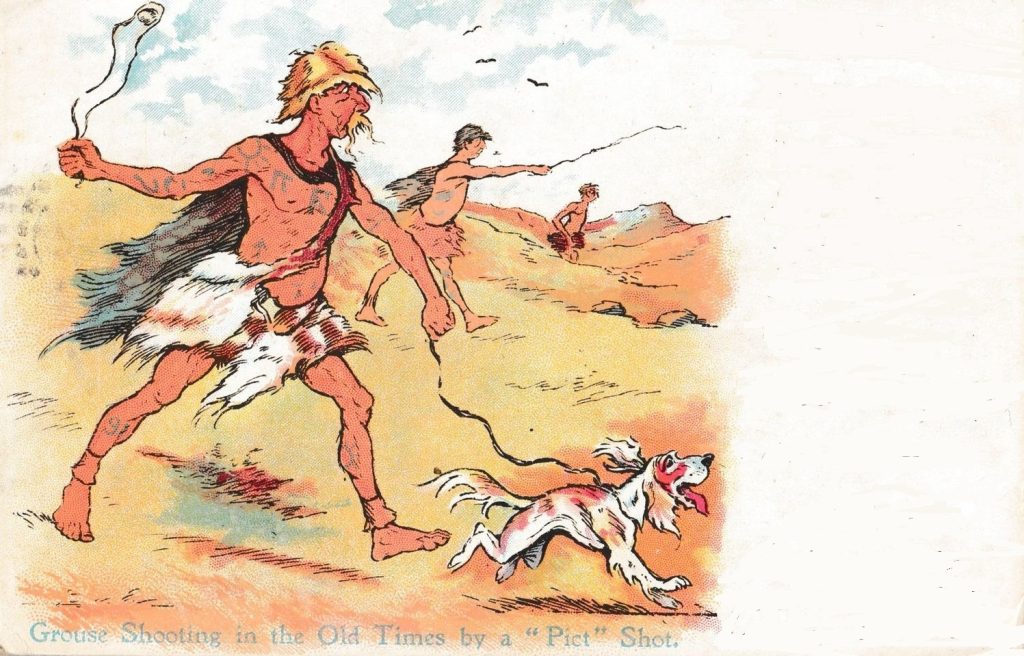Bob Teevan
Grouse Shooting in the Old Times
This postcard was selected to portray a leisure activity. It is an early card published by McCaw Stevenson & Orr Limited of Belfast and London. It is titled Grouse Shooting in the Old Times by a “Pict” Shot. The image depicts what is presumed to be a mustached and woad tattooed Pictish man hunting with a dog and a slingshot. If Grouse Shooting is too violent a leisure activity for you then we’ll tick the leisure activity box by suggesting he is dog walking.

Marcus Ward & Company was a long-established Belfast printing company that specialized in the production of colored paper products including postcards. The company had an excellent reputation for issuing quality printed cards. And was said to have “for a while monopolized the whole of the better-class trade.”
The card does have a feel of quality about it and the excellent illustration remains as fresh and as detailed as the day it was printed. Regrettably, the company went into liquidation in 1899 and in 1900 the entire business and goodwill was acquired by its Belfast rival McCaw Stevenson & Orr. This card is postmarked October 1903 and as it bears the names of both companies, I suspect it was an illustration once owned by Marcus Ward.
For the benefit of foreign readers, the Picts were a tribal group of Celtic people who lived in the east and north of Scotland in iron age and medieval times. They are reputed to have been fierce warriors and to have halted the Roman invasion of Scotland. In reality the invasion ended due to troubles in Rome and there being no economic benefit in occupying the northern regions of Scotland.
On first glance, the dog depicted in the image was thought to be a spaniel, and it appeared to be an artistic error. The origin of the word spaniel is from the Old French word espaigneul which meant Spanish and it was easy to believe that Spaniels were late arrivals to the UK – around the time of Charles the First. However other readings suggest that the spaniel is a hunting dog which could have been brought to the British Isles as early as 900 BC. The illustration is likely accurate.
The red grouse is usually found in heather covered moorlands in Scotland and is a reddish-brown bird with black tail and white legs. Males tend to be more reddish in color than the females with white stripes on the underwing and red combs over the eyes. Grouse shooting is permitted from August to December and as a sport it brings significant tourism to Scotland.
The shooting of haggis is permitted all year round although it is not as popular a sport, for capturing haggis is relatively easy. The haggis – which is not a bird but more a rabbit sized animal – has four legs with those on the left-hand side of the beastie being about half the length of those on the right. This greatly assists the haggis in climbing the Scottish mountains in a counterclockwise direction, so all one has to do is to force the slow-moving animal to turn 180 degrees at which point it rolls downhill for easy gathering. Surely you agree – not much sport.
Without malice, some readers may have been led to believe that – like the Loch Ness Monster – the Scottish haggis is a mythical creature. Not to leave stones unturned an attempt was made to find evidence. It came within an earlier post in which was referenced a business in the town of Largs which boasted “A. D. Paton. Quality Butchers since 1840” and “Licensed Game Dealer,” who was no ordinary butcher as the shop boasts that “Whilst building their fine reputation for quality Scottish produce, Patons Butchers are justifiably proud of their freshly shot haggis which is available in season.”
There is a caveat for non-Scots which advises, “The haggis is Britain’s rarest bird and is so named because of its habit of nesting in peat haggis. Specially protected, it is now found only in the Parish of Crathie and Braemar.
It feeds on the Alpine Ice Worm, which it catches by walking on the eternal snow beds, scratching with its near side foot. Over the centuries, this habit, along with the fact that the bird is always on steeply sloping ground, has led to a grotesque over-development of the near side leg and foot, so that the poor haggis can no longer turn round or stand on level ground.
Once a national delicacy, the haggis was so over-hunted that it was eventually declared a royal bird, to be killed and eaten only by members of the Scottish royal family.
During the lifetime of Robert Burns, in an attempt to save the still declining stock, the delicious pudding bearing the same name was introduced as a substitute delicacy. Burns, a keen conservationist, wrote his famous poem, To a Haggis, and is now considered to have saved the haggis bird from certain extinction.
The breeding stock is very closely monitored and on April 1st of each year, Braemar Mountain Rescue team reports direct to the Secretary of State for Scotland on the number of breeding pairs and eggs laid.
Actually there is no such bird as a haggis, it is only a myth, (like the lock ness monster)
But the tale has been around for a long long time
Fun reading but could be even more fun eating. Thank you.
Interestingly, the haggis is described as “not a bird” in one sentence, and “Britain’s rarest bird” a couple of sentences later.